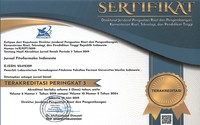Pengembangan Ekstrak Etanol Limbah Biji Pepaya (Carica papaya L.) Sebagai Serum Antijerawat
Abstract
Acne or commonly called acne vulgaris merupahkan abnormalities in the skin that almost everyone has experienced it. Acne is a problem of skin, neck, chest, and back that occurs in times of skin-the skin of the skin will be clogged by excessive fat deposits. Propionibacterium acnes is a gram-positive bacteria as part of normal flora and fauna. Papaya seeds are agricultural waste that has antibacterial activity against the bacteria Propionibacterium acnes with a very low cost. One of the proper acts for acne problem is by using serum. Serum has a very fast absorptive effect to penetrate the inner skin without the effects of sticky effects on the skin. By knowing that the bacteria Propionibacterium acnes can cause acne that can attack various circles and know the benefits of papaya seeds that inhibit the growth of acne-causing bacteria, it is necessary to formulate papaya seed estrak as antijerawat, so this process formulates the serum preparation of papaya seed estrak which can as pen prevent the growth of acne-causing bacteria. The research method that will be done is the initial processing of the sample by extraction and then proceed with formulation of the preparation. After that, the evaluation of serum preparation and antibacterial activity test are available on the preparation.
Full Text:
PDF (Bahasa Indonesia)References
Ditjen POM, 1985. Formularium Kosmetika Indonesia. Jakarta. Departemen Kesehatan RI.
Draelos, Z.D. & Lauren, A.T., 2010. Cosmetic Formulation of Skin Care Products. 326. Taylor and Francis Group. New York.
Fatmawati N, Anwar E, Azizahwati. Formulasi Serum Penghambat Kerja Tirosinase yang Mengandung Fitosom Ekstrak Biji Lengkeng (Dimocarpus longan Lour) Menggunakan Eksipien Koproses Kasein – Xanthan Gum. FF UI. 2014.
Emma S.K, Iskandarsyah, Praptiwi. Evaluasi, Uji Stabilitas Fisik dan Sineresis Sediaan Gel yang Mengandung Minoksidil, Apigenin dan Perasan Herba Seledri (Apium graveolens L.). Jurnal. Fakultas Farmasi UI. Bul. Penelit. Kesehatan, Vol 42, No. 4, Desember 2014: 213-222
Mitsui, T. 1997.New Cosmetic Science.Tokyo : Shiseido Co., Ltd.
Naibaho, Olivia H. Paulina V.Y. Yamlean, Weny Wiyono., 2013. Pengaruh Basis Salep Terhadap Formulasi Sediaan Salep Ekstrak Daun Kemangi (Ocimun Sanctum L.) Pada Kulit Punggung Kelinci Yang Dibuat Infeksi Staphyloccocus Aureus. Jurnal Ilmiah Farmasi. UNSRAT. Vol 2 N0 02. ISSN 2302-2493.
Rahmi AH, Cahyanto T, Sujarwo T, Lestari RI. Uji Aktivitas Antibakteri Ekstrak Daun Beluntas (Pluchea indica (L.) LESS.) Terhadap Propionibacterium acnes Penyebab Jerawat. Jurnal. Fakultas Sains dan Teknologi UIN Sunan Djati Bandung. Edisi Juni 2015. Volume IX No.1.
Septiani S, Wathoni N, Mita SR. Formulasi sediaan masker gel antioksidandari ekstrak etanol biji melinjo (Gnetum gnemon Linn.). Jurnal Universitas Padjadjaran. 2011;1(1):4-24
Syarifah F, Mulyanti D, Priani SE. Formula Edibe Film Ekstrak Biji Pepaya (Carica Papaya L.) dan Uji Aktifitasnya terhadap Bakteri Klebsiella Penumoniae dan Staphylococcus Aureus. Prosiding Penelitian SPeSIA Unisba. 2015.
Tranggono, Retno I. Buku Pegangan Ilmu Pengetahuan Kosmetik. PT Gramedia Pustaka : Jakarta.
DOI: https://doi.org/10.33096/jffi.v7i1.458
Copyright (c) 2020 Jurnal Fitofarmaka Indonesia

This work is licensed under a Creative Commons Attribution-ShareAlike 4.0 International License.
Indexed by:
ISSN: 2356-0398 | e-ISSN: 2541-2329
Editor's Address:
Third Floor Pharmacognosy-phytochemistry laboratory building, Urip Sumoharjo road km. 5 Campus II UMI, Makassar, South Sulawesi, Indonesia
Phone: +6281524045514
Fax: +62411425619
E-mail: editorjfi@umi.ac.id

















.jpg)

